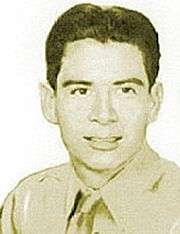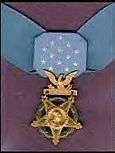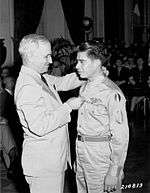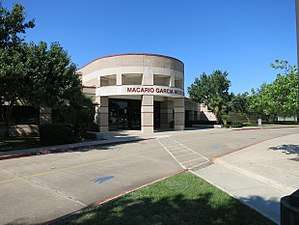Marcario García
| Marcario (Macario) García | |
|---|---|
  Staff Sergeant Marcario García, Medal of Honor recipient | |
| Born |
January 20, 1920 Villa de Castaño, Mexico |
| Died |
December 24, 1972 (aged 52) Houston, Texas |
| Place of burial |
Houston National Cemetery, Houston, Texas |
| Allegiance | United States of America |
| Service/ | United States Army |
| Years of service |
United States Army: 1942-1945, United States Army Reserve: 1946-1972 |
| Rank | Command Sergeant Major |
| Unit | Company B, 1st Battalion, 22d Infantry Regiment, 4th Infantry Division |
| Battles/wars | World War II |
| Awards |
Medal of Honor Bronze Star Medal Purple Heart |
Staff Sergeant Marcario García[1] also known as Macario García [note 1] (January 20, 1920 – December 24, 1972) was the first Mexican immigrant to receive the Medal of Honor, the United States' highest military decoration. He received the award for his heroic actions as a soldier during World War II.
Early years
García was born in Villa de Castaños, Mexico in the state of Coahuila. In 1924, Garcia's family immigrated to the United States in search of a better way of life. He lived in Sugar Land, Texas where he worked as a cotton farmer.[2]
Upon the outbreak of World War II, Garcia joined the United States Army at a recruiting station in his adopted hometown in November 1942.[3] He was assigned to Company B, 22nd Infantry Regiment, 4th Infantry Division.
World War II
On November 27, 1944, García was an acting squad leader in his platoon, which found itself engaged in combat against the German troops in the vicinity of Grosshau, Germany. Realizing that his company could not advance because it was pinned down by enemy machine gun fire, Garcia, on his own initiative, went ahead alone, destroying two enemy emplacements and capturing four prisoners. Despite being wounded himself, he continued to fight on with his unit until the objective was taken.[4]
Medal of Honor citation
Honors and discrimination

On August 23, 1945, the President of the United States, Harry S. Truman presented Staff Sergeant García with the Medal of Honor at a ceremony in the White House. A month after he was awarded the Medal of Honor, Garcia was denied service at a restaurant located in a town just a few miles south of Houston because he was Hispanic. Garcia was beaten with a bat by the owner. No one was arrested and no charges were initially filed. It was only after national columnist Walter Winchell reported the incident and labeled Sugar Land the most racist city in America that charges were filed—against Garcia. Then the incident was covered by the news media, and caused an uproar amongst the Hispanic community who rallied to his aid. The nation was made aware as to the discriminatory policies that Hispanics were subject to, as the case against Garcia was repeatedly postponed before being dropped.[6]
Later years

García became an American citizen on June 25, 1947 and earned a high school diploma in 1951. On May 18, 1952, he married Alicia Reyes with whom he had three children. For twenty-five years he worked as a counselor in the Veterans' Administration.[6]
On the evening of November 21, 1963, Marcario García greeted President John F. Kennedy at the door of the Rice Ballroom in Houston Texas. The ballroom was filled with a diverse crowd of attendees that included Hispanic World War II veterans, Civil Rights advocates and future political activists.[7] The president spoke of U.S. and Latin American Foreign Policy and the importance of recognition and acknowledgement of Hispanic organizations like the League of United Latin American Citizens (LULAC). Speaking in fluent Spanish, Mrs. Kennedy offered words of inspiration and encouragement. The day after this meeting Kennedy was dead.
García died on December 24, 1972, from the injuries which he received as a result of a car accident. He was buried with full military honors in the Houston National Cemetery in Houston, Texas. The local government of Houston honored his memory by naming a middle school after him as well as renaming part of 69th Street in Houston "S/SGT Marcario García Street". In 1983 Vice President George Bush dedicated Houston's new Macario García Army Reserve Center, and in 1994 a Sugar Land middle school was named in García's honor.[6]
Awards and recognitions
Staff Sergeant Marcario García's decorations and medals were the following:
| Purple Heart | ||
| American Campaign Medal | European-African-Middle Eastern Campaign Medal | World War II Victory Medal |
Foreign award
- Mérito Militar - Mexico
Notes
- ↑ It should be noted that his "Medal of Honor citation" and some websites referrer to the subject as "Marcario" while in some other websites the subject is referred to as "Macario"
See also
References
- 1 2 "Medal of Honor recipients". Medal of Honor citations. United States Army Center of Military History. August 3, 2009. Retrieved July 1, 2010.
- ↑ Texas State Historical Association
- ↑ WWII Army Enlistment Records
- 1 2 Medal of Honor citation at homeofheroes.com
- ↑ First name according to the Congressional Medal of Honor Citation
- 1 2 3 García, María-Cristina (June 15, 2010). "García, Macario". Handbook of Texas Online. Texas State Historical Association.
- ↑ "Houston Chronicle", December 25, 1972, November 26, 1994. Houston Post, September 7, 1945, December 26, 1972. New York Times, August 9, 1945
Further reading
The following books make references to Marcario García's exploits.
- Medal of Honor: Historical Facts And Figures, page 167, by Ron Owens
- The Battle of Hurtgen Forest (West Wall Series) (West Wall), page 133, by Charles Whiting
- The Quest for Tejano Identity in San Antonio, Texas, 1913-2000 (Latino Communities: Emerging Voices—Political, Social, Cultural and Legal Issues), page 56, by Jr., Richard Buitron and Richard Buitron
- ÁRaza Sí! ÁGuerra No!: Chicano Protest and Patriotism during the Viet Nam War Era, page 36, by Lorena Oropeza
- Moon Handbooks Charleston and Savannah (Moon Handbooks), page 115, by Mike Sigalas
External links
- "Discovery UT Austin". Retrieved October 4, 2010.
- "Houston National Cemetery". Retrieved October 4, 2010.
- "The Fearless Mexican". Archived from the original on February 2, 2011. Retrieved October 4, 2010.
- Stanley Jozwiak. "Battle in the Hurtgen Forest". 1st Battalion 22nd Infantry website.